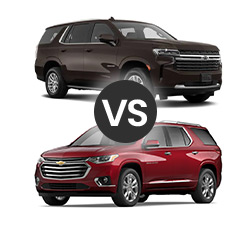2021 Chevrolet Tahoe vs Traverse
Out of the vast selection of three-row SUVs, two models that shine through are the Chevrolet Tahoe and Traverse. Both vehicles come equipped with dependable engines for a secure ride along with spacious interiors to fit large groups comfortably; however there's more separating them than meets the eye! The sophisticated styling of the Tahoe sets it apart from its sibling, creating an upscale feel not found in other comparable vehicles. That said, don't discount what makes up this duo - while one may be deemed "the better option", both offer remarkable features making either choice solid.
Size and Styling
The Tahoe is an impressive giant in the SUV market, boasting 122.9 cubic feet of maximum cargo capacity - a number few models can match! The Traverse also stands out for its spacious interior; with 89.75 cubic feet at your disposal, there's plenty of room to take all you need on whatever adventure comes next.
Both SUVs have three rows of seats. The Tahoe can have a few different configurations. It can fit seven passengers if it has front bucket seats, captain's chairs in the middle row, and a bench in the third row. It can fit eight if it has a bench seat in its middle row; this is a common layout. It can also fit nine if a customer chooses to get a bench seat in the front row. This is only an option on the base trim, which is the LS.
In the Traverse, customers don't have an opportunity to get a front-row bench seat. Instead, every trim comes with two bucket seats in the first row. Like the Tahoe, the Traverse has a third row that can fit three passengers. Its middle row can either have a bench seat or captain's chairs, so the Traverse can have room for seven or eight total people.
The front and second rows of the Tahoe are quite spacious. Up front, there is up to 44.5 inches of leg room. In the second row, there's 42 inches of leg room, which is more than what most vehicles offer. The third row is smaller, but still relatively roomy, with there being 34.9 inches of leg room. Adults should be able to fit back there without too much of an issue.
The Traverse may not have the same large size as its competitors, but it certainly doesn't compromise on leg room! With 33.5 inches of space in the third row and 38.4 inches in the second row, even adults won't feel cramped when sitting back there - plus they can enjoy up to 41 luxurious inches of front-row legroom!
With an overall length of 204.3 inches, 78.6 inches in width and 70.7 inch height, the Chevy Traverse is slightly smaller than its counterpart - the Tahoe - which measures 210.8 x 81 x 75.8 respectively yet still remains well above average size among SUVs on today's market; making it a prime choice for those looking to combine ample road space with maneuverability in their next vehicle purchase decision!
The Tahoe is known for its impressive ground clearance of up to 8 inches, giving it an edge over the Traverse's 7.51 inch height. Select models can even reach a maximum 10 inches - great if you plan on driving off-road and need extra clearance! At the same time families still seek vehicles that their children will find comfortable accessing when getting in and out.
Chevys SUVs offer an unequalled mix of power and style. The Tahoe's imposing frame and 22-inch wheels provide a rugged look that suits all types of adventures, while modern touches like LED lights create a sleek silhouette. Meanwhile, the Traverse commands attention with its bold 20 inch rims alongside classic bowtie emblems for added flair.
You can personalize your driving experience with our two models. For a bold look, the Tahoe and Traverse offer blackout features, or you may go for chic sophistication thanks to chrome accents available on select trims! Illuminate the way with LED Daytime Running Lamps as standard equipment in both vehicles; plus get bright illumination from either optional LED headlamps on the Traverse or included standard on every trim of Tahoe.
The Traverse brings convenience and comfort to the road. It offers premium features such as a power-operated programmable liftgate or hands-free option, side rails on the roof for extra protection, fog lamps for better visibility in low light conditions, assist steps that make getting into your car easy - plus an eye catching two panel sunroof where you can let fresh air flow inside while admiring breathtaking views outside.
The Chevy Tahoe packs a punch with its incredible range of features! From automatic wipers to projectible emblems and even power-retractable steps that light up as you approach, it's no wonder the Tahoe has become one of the most sought after vehicles. And if that wasn't enough, all trims come equipped with an amazing panoramic sunroof - perfect for taking in those stunning views on your next road trip!
Drivability
With the Chevrolet Tahoe, capability is king. From a reliable 5.3-liter V8 packing 355 horsepower and 383 pounds of torque to an impressive 10-speed automatic transmission engineered for your toughest hauling needs - the mighty SUV can handle it all! Whether you're running daily errands or heavy lifting up 8400 pounds with proper equipment, this full size behemoth is ready to conquer any challenge thrown its way. Take command in one powerful package -all that stands between you and success: The Chevrolet Tahoe!
The High Country trim of the Tahoe packs a punch with its mighty 6.2-liter V8 engine, supplying an impressive 420 horsepower and 460 pound-feet of torque to put you in control behind the wheel! With such robust power at your disposal, any journey will feel like a breeze no matter where it takes you.
The Tahoe offers drivers the power of choice; they can opt for a traditional 6.2-liter V8 engine offering 460 pound feet of torque, or switch things up with a cutting edge turbo diesel that boasts 277 horsepower and an impressive three liters displacement.
With all of this power, the Tahoe isn't going to surprise anyone with its fuel economy. As expected from a SUV of this size, it doesn't do that well in this area. The best it can do is an estimated 22/26 (city/highway) miles per gallon, and that's with a diesel running it. A Tahoe with a 5.3-liter engine earns an estimated 16/20 miles per gallon, and one with the larger V8 has a fuel economy of 15/20 miles per gallon. Having all-wheel drive could slightly lower those numbers.
Despite its size, the Traverse does surprisingly well in terms of fuel economy. This efficient marvel boasts impressive ratings of 18 mpg city and 27 mpg highway - not bad considering it has all the features that come with a large SUV.
The Traverse is a powerful family hauler, powered by an impressive 3.6L V6 engine capable of generating up to 310 horses and 266 lb-ft torque - all managed through Chevy's nine-speed automatic transmission.
The Traverse and Tahoe both offer a versatile experience, allowing drivers to choose between the power of all-wheel drive or classic rear-wheel prowess. The latter provides an engaging driving feel that has been favored among high performance vehicles such as sports cars and luxury SUVs for many years – perfect for those who want sharp control on every turn.
The Chevrolet Traverse is equipped with the state-of-the art StabiliTrak system for enhanced stability and traction, as well as an automatic stop/start option to save on gasoline when idle. For those who like to tow or haul cargo, optional trailering equipment can manage up to 1,500 pounds of weight - so nothing will be left behind!
The Tahoe offers unparalleled ride comfort, no matter how bumpy the terrain. Its adjustable air springs make for a more balanced and smooth drive; meanwhile, its multi-link rear suspension alongside coil-over shock up front ensures passengers are in safe hands whatever their load may be. The ultimate road warrior awaits you in this SUV!
The Tahoe steps up to the plate when hauling cargo with its impressive trailer sway control. With an advanced monitoring system capable of detecting steer input, it can apply brakes accordingly and keep your load in check. Worried about tire blow outs? Not a problem – this SUV also has a trusted Tire Pressure Monitoring System so you know exactly where they're at!
The Tahoe is built to conquer the toughest of terrains with its smart programs packed into one unbeatable package. When you're navigating a rocky road or trail, it's got your back - thanks to its limited-slip rear differential which keeps both wheels spinning at equal speed! With either single-speed or two-speed transfer cases available, this machine packs all the power and control for any journey.
Comfort, Options and Performance
Chevy SUVs come complete with all the modern amenities you'd expect, from wireless Apple CarPlay and Android Auto to integrated navigation systems. Depending on your trim selection, enjoy luxuries like a Bose sound system plus ten speakers for an unforgettable listening experience - or get cozy in 10.2-inch touchscreen comfort! Plus access Bluetooth connectivity, SiriusXM Satellite Radio anywhere you go and even WiFi capability if needed.
The Traverse offers luxurious convenience with its seven- to eight-inch touchscreen, depending on the trim. But those looking for access to SiriusXM will need a higher level of sophistication than the base model provides. Meanwhile Apple CarPlay and Android Auto are available -- just not wirelessly!
Seating material in both the Tahoe and Traverse ranges from cloth to perforated leather. Many trims have heated front seats, with the more premium ones having heated and ventilated front seats and heated rear seats. Even the steering wheels in these SUVs can be heated. Minor features like these can really enhance the overall driving experience, and many customers are prepared to pay extra for these types of things.
SUV makers such as Tahoe and Traverse provide top trims that rival their luxury counterparts. With features like power-adjustable steering, remote start capability, memory settings for driver convenience and a rearview camera mirror with real time feed of the back view even when vision is obstructed; these vehicles have everything you need to navigate through life's roads in style!
To avoid overpaying on a new car, shop prices online first. Get up front pricing before you walk into a dealership. We recommend the following free services; Car Clearance Deals, NADAguides, CarsDirect & & Motortrend.
These free services will offer you the lowest prices and supply you with multiple competing price quotes. You will know the best price before you visit the dealer.
Safety
Chevrolet vehicles are a step ahead of the game when it comes to safety. Equipped with driver-assist technologies, these SUVs can detect potential risks on the road before you do and take corrective measures if necessary - giving you peace of mind while driving!
The standard list of driver-assist systems in the Tahoe includes forward collision alert, pedestrian detection, a following distance warning function, and automatic emergency braking. It also has a a rear park assist feature that lets drivers know when they're getting too close to objects.
Higher trims of the Tahoe have front and rear parking assist, which can come in handy when parallel parking or parking in a garage. These higher trims will have blind zone monitoring, rear cross traffic alert, and lane keep assist. The blind zone monitoring system can be enhanced to take the length of a trailer into account.
If you're looking for extra peace of mind behind the wheel, some convenience features come standard on higher-end versions of the Traverse. You can look forward to automatic braking and collision alerts as well as a blind zone monitoring system that won't be found in lower trims - but are available optionally when stepping up from base level models.
Driving has just become a whole lot easier with the Tahoe and Traverse's HD surround vision camera! Enjoy parking at ease, knowing these cameras capture every angle to guide your SUV safely into those tight spots.
Which Model to Choose?
With a seemingly endless list of features and amenities, the Chevy Tahoe stands out as one of Chevrolet's most popular vehicles. As compared to its Traverse counterpart, it offers plenty more power from three distinct engine choices. But that's not all - this SUV also boasts superior technology and safety systems for added peace-of-mind behind the wheel.
The Tahoe is a luxurious SUV, packed with features; however, its premium price tag may be too much for some potential buyers. Starting at $51,295 and ranging up to an eye-watering $71,395 for the High Country trim without any extras included - it's no surprise that many people must look elsewhere when searching for their perfect ride.
The Traverse offers drivers a variety of price points, from its competitively-priced entry model at $30,995 to the top trim level's luxurious features for just over $50k. With such an impressive range in cost and quality that dwarfs many competitors - like the Tahoe - it makes outfitting your vehicle with all your desired bells and whistles more feasible than ever before!

Get up to 4 local dealers to compete for your business by offering free, competitive pricing. Know before you go to the dealer.
Every dealer offers a secret price. Find yours here.
• 2021 Chevrolet Tahoe VS Dodge Durango
• 2021 Chevrolet Tahoe VS Ford Expedition
• 2021 Chevrolet Tahoe VS Ford Explorer
• 2021 Chevrolet Tahoe VS GMC Yukon
• 2021 Chevrolet Tahoe VS Nissan Armada
• 2021 Chevrolet Tahoe VS Toyota Sequoia


